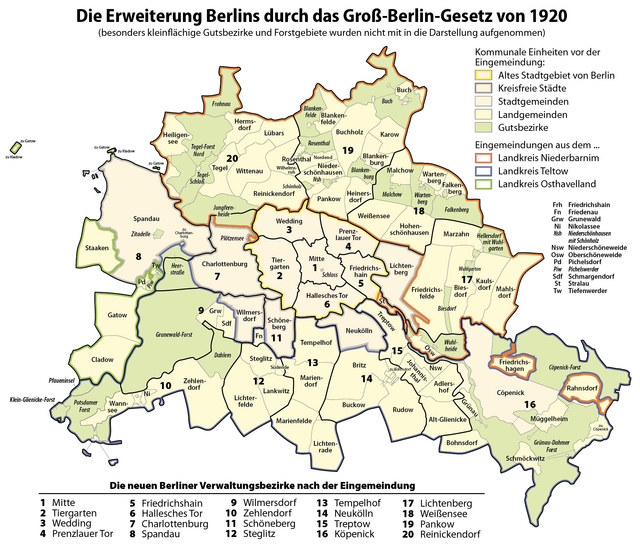Groß-Berlin or Greater Berlin was created by an act of the Prussian parliament made on 27 April 1920. The act was called the Greater Berlin Act (German: Groß-Berlin-Gesetz) for short. Its full name was the "Law Regarding the Reconstruction of the New Local Authority of Berlin" (German: Gesetz über die Bildung einer neuen Stadtgemeinde Berlin).
- The title of this article contains the character ß. Where it is unavailable or not wanted, the name may be written as Gross-Berlin.


The act said that on 1 October 1920 Greater Berlin should be taken away from the Province of Brandenburg and become a new district.
The new district was made up of:
- The city of Berlin (Alt-Berlin);
- 7 towns that surrounded Berlin:
- 59 rural areas and 27 estate districts from the surrounding districts of Niederbarnim, Osthavelland and Teltow;
- and the grounds of the Berliner Stadtschloss (the Royal Palace) which had formed an estate district in its own right.
The new Berlin was 13 times bigger than the old. Its area went from 66 km2 (25.5 sq mi) to 883 km2 (340.9 sq mi) and the population doubled from approximately 1.9 million to near 4 million, with almost 1.2 million of these new inhabitants coming from the 7 surrounding towns alone.
Groß-Berlin was divided into 20 boroughs (Verwaltungsbezirke):
- from Alt-Berlin:
- one borough for each of the 7 previously-independent towns:
- 7 new boroughs named after the largest village in the old areas:
- Pankow,
- Reinickendorf,
- Steglitz,
- Tempelhof,
- Treptow,
- Weißensee and
- Zehlendorf
Apart from minor changes, the city boundary defined in the law is the same as today, except for some changes made during the time of the Berlin Wall. During the 1970s and 1980s three new boroughs were made in East Berlin when other boroughs were split up.
Other websites
- text of the law (in German) Archived 2017-08-13 at the Wayback Machine
Wikiwand in your browser!
Seamless Wikipedia browsing. On steroids.
Every time you click a link to Wikipedia, Wiktionary or Wikiquote in your browser's search results, it will show the modern Wikiwand interface.
Wikiwand extension is a five stars, simple, with minimum permission required to keep your browsing private, safe and transparent.
